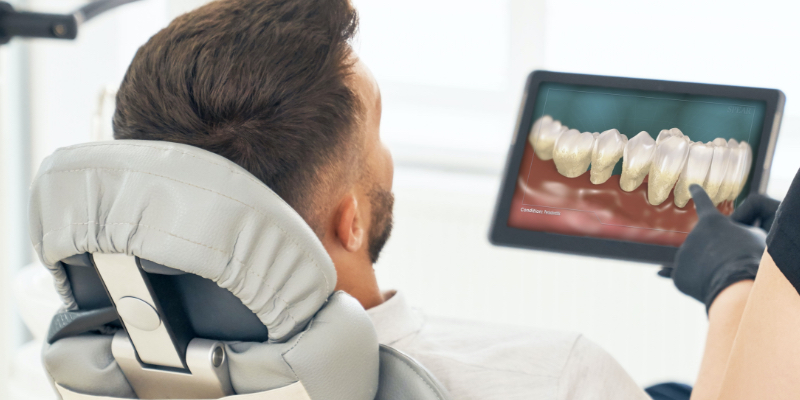Profile of a ‘Bad Patient:’ Why Honest Communication Wins
Over the years, I have learned to accept that I am a unique patient. My experiences over the past six years overseeing the creation of Spear’s clinical content have given me oral health experiences have given me a better understanding of dentistry than your average non-clinical person.
For instance, I know all about the “potential consequences of inaction” from many of my own dental conditions, and had those in mind as I led development of the Patient Education platform. I knew of those potential consequences also from my years of partnering with dental faculty to build countless study club modules, online content, and campus courses. However, I also have a clear understanding of the unbelievable clinical outcomes that are possible.
Despite all the knowledge, I admit I am a terrible patient – a well-meaning, non-compliant bite.
I have a history of periodontal disease with acid reflux, bruxism, and airway issues. I discovered how good I was at bruxing as I went through ortho as an adult. I broke four wires and 16 brackets, including one that I broke in my sleep. I would chew through bite pads in 1-2 days and I managed to take 3 mm off my canine in the 20 months that I had the brackets on. I say this only to clearly state that I have a lot of issues, but also a comprehensive understanding of not only the “what” by the “why,” compared to the average patient.
Normally, I am on a 90-day periodontal recall but at some point pre-COVID I canceled an appointment due to a conflict at work. I canceled in a voicemail and meant to call to reschedule but I forgot. Then I fell into a pattern all too familiar to dental practices.
I would tell myself in the morning to call my doctor and set up an appointment but then I would get wrapped up in the day. The office called but it was always at a time when I was unable to answer the phone. So after a few months, it completely slipped my mind.
This went on for about four months and then COVID hit. By the time I got back to my doctor, it had been nearly a full year.
The Struggle to Connect With Patients
After a heroic effort by the hygienists, I was back on track, and it turned out the damage was minimal (at least as far as pocket depths go). On my way out, I was paying and confirming my next appointment when a front office team member looked at the gap since my last appointment and told me:
“You were gone for quite a while, shame on you.”
To be clear – this was a joke! It was appropriate for me, in the context of my relationship with the office, and it was accompanied by an exaggerated facial expression and even a playful finger wag.
Also, to be clear, my dentist runs a great practice. The entire practice team operates like a well-oiled machine, and the doctor does a lot of little things to go above and beyond to build trust and loyalty with his patient base.
This is not a unique joke. I’ve learned how to be a “well-meaning non-compliant.” I have heard this from various team members in medical offices, dental practices, and mechanics when I bring my car in for routine maintenance.
I do not find it offensive. I tend to reply with the requisite over-the-top sheepish expression and smile.

Dental Practice Management Geared Toward Strong Patient Flow
This time, however, when I returned to work, my next call was with Spear Faculty and other thought leaders. I was reminded (for the hundredth time) of the importance of patient retention in the financial health of a practice. When I discuss practice challenges with dentists, new patient flow inevitably comes up.
Most clinicians feel they need more or “better” patients, and that alone will solve their problems. But the reality is, and we know this from consulting clients, that while new patients are important, most practices have a leaky bucket that they are not aware of.
You will never bring in enough new patients if you are losing 20% or more of your patient base each year. Solving this issue requires a multi-pronged approach from scheduling chairside to great systems and talk tracks to ensure no patient slips through the cracks.
I’ve recently reflected on my own oral health experiences in a new light. Practices should be putting the same thought and effort into welcoming reactivated patients as they would new ones. In many ways, the reactivated patient is even more valuable than those coming in the door for the first time.
“You will never bring in enough new patients if you are losing 20% or more of your patient base each year. Solving this issue requires a multi-pronged approach from scheduling chairside to great systems and talk tracks to make sure no patient slips through the cracks.”
Encouraging an Attitude of Patient Responsibility and Engagement
The conversation at the front desk in my dentist’s office was a missed opportunity. Instead of the joke, which ultimately may elicit shame in some patients and create a barrier, the next time someone falls off the track and returns, why not celebrate what really happened?
The patient returned because they value their oral health. What if the front office team member said something more like:
“Wow, you were gone for a while! It is great that you made it back to get this taken care of. Good for you! Not everyone does.”
This promotes more of an attitude of camaraderie in oral health, encouraging the patient to continue to be an active participant in their treatment plan and oral health in their treatment plan and oral health.
It is a simple shift, but it leaves the patient feeling proud of what they did, ultimately building loyalty with your practice.
SPEAR ONLINE
Team Training to Empower Every Role
Spear Online encourages team alignment with role-specific CE video lessons and other resources that enable office managers, assistants and everyone in your practice to understand how they contribute to better patient care.

By: Adam McWethy
Date: February 1, 2021
Featured Digest articles
Insights and advice from Spear Faculty and industry experts



